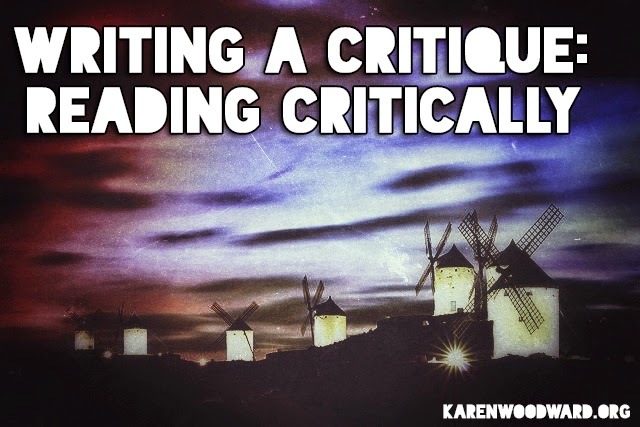 |
This title should read “How I Critique A Story” because that’s what I’ll be writing about, but it just didn’t have the same ring to it!
One of my New Year’s resolutions this year is to do more constructive critiques of others work—and to submit more of my own work for critiquing!—so I thought I’d write a blog post about ... well, not so much about how to write a critique, but about how to read critically and, from one’s close reading, how to develop a critique.
This post was originally about 2500 words so I’ve divided it into two. Today we’ll look at how to read critically and on Monday we’ll finish up that discussion and talk about transforming one’s notes into a critique.
Index:
Writing A Critique: Reading Critically (Current Post)
Reading Scenes Critically
Index:
Writing A Critique: Reading Critically (Current Post)
Reading Scenes Critically
Reading Critically
Before we roll up our sleeves and dive in, let’s talk about levels.
There are two ‘levels’ to a story: the story itself, and the scenes (and sequels) that make up the story. Let’s call these two levels the “story level” and the “scene level.”
Story Level
First, a note on terminology. By “protagonist” I mean the main character in a story. Which character is the protagonist is obvious in a story told from only one point of view, but many stories are told from multiple points of view. In this case I refer to each POV character as a main character. In this case, while each main character will have their own story arc there will still be one arc that draws all the others together. I call this character the protagonist.
Significant characters are characters who are important enough to the story to have their own goals, their own character arcs, within the story.
Clear as mud? (grin) If you have any questions about how I use these—or any other—words or phrases, please do ask.
Story Level: Characters
- Who is the protagonist? If there is more than one main character, is one character more important to the overall arc of the story than the rest?
- If there is more than one POV character, is one of these more important to the story than the others? If so, generally this character has the initial POV as well as the final POV. Of course, there can be exceptions, but, if so, ask yourself: why? If you can’t think of a good answer, this might be something to note in your critique.
- What is the main character’s goal?
- If there is more than one POV character, what is each POV character’s goals? How does each goal connect up to the goal of the main character?
- If the protagonist achieves her goal, can the antagonist? (And vice versa.) The answer should be a resounding “No!”
- What are the stakes? What will happen to the protagonist if she doesn’t achieve her goal? (Ask this about each of the significant characters.)
- Are the characters memorable?
Jim Butcher talks about how to create memorable characters in his excellent article: Characters. Briefly:
a. Does the character have an exaggerated feature? This feature can be physical, mental or emotional. Exaggerated traits are both interesting and memorable.
b. Does the character act believably? That is, do they (a) have an emotion which leads to a (b) reaction, which leads finally to a (c) decision?
c. When the character is introduced—the very first time your readers see the character—is she (a) introduced in action? Does this action clearly and sharply typify the essence of the character?
- Is the protagonist introduced before any of the other characters? This isn’t necessary, but if another character is introduced first, ask yourself what doing so adds to the story. Would the story gain by having the protagonist introduced first?
Characters and story threads or story arcs
- Is there a story thread for each significant character?
- Does each story thread have a clearly defined goal?
- Does each story thread have clearly defined stakes? Each story thread should have stakes attached to it, depending on whether the (significant) character of the thread attains their goal. Further, these stakes should increase over time.
Story Level: Genre
- Is the genre clear? Are the special rules of that genre met?
Each genre has its own rules, it’s own structure. For example, if a story appears to be a murder mystery (a murder occurs at the beginning, this event incites the protagonist to sleuth about trying to uncover the miscreants identity, and so on) but there’s no reveal at the end, and so we are left wondering who committed the crime, then that’s a problem.
Why? Because anyone who reads this book because it’s a murder mystery will expect the story to obey the rules of the genre. Readers will expect the sleuth to not only figure out who committed the crime but to reveal who committed the crime. Also, the murderer should either die at the end or be brought to justice. This allows for peace to be restored. (The meting out of justice brings things full circle, back to the peace and security of the Ordinary World.)
If the story isn’t brought full circle, the average reader will regard it as unfinished and may even be tempted to throw the book across the room. (If it’s an ereader, that could get pricy!)
Critiquing: Scene Level
Often, perhaps too often, we only talk about the story goal, the initial (or final) stakes, etc. But, really, a reader never really reads a book, they read a series of scenes that, when strung together, forms a story.
Scene level analysis: Character
- What are the names of all the characters in the scene?
- What are each character’s tags and traits? For more on tags and traits see:
- What role does each character play in the scene?
About Character Roles
There are two ways of looking at this (there are likely many more than two, but these are the two I use most often):
a. Archetypes
In “The Writer's Journey: Mythic Structure for Writers,” Christopher Vogler listed a number of archetypes especially relevant to story development. To read more about this, I recommend the short article Vogler has on his website. It lists all the archetypes and explains what he means by the hero’s journey. (See: Hero’s Journey.)
Generally, while a character may exemplify more than one archetype over the course of a story, she will only exemplify one at a time. For example, while a mentor may turn out to be a nemesis, in the beginning scenes they will act as a mentor and in the latter as a nemesis. You get the idea.
b. Tropes
I’ve found that tropes are much like archetypes, but more finely grained. For example, rather than speaking of a character as a mentor, one speaks of either a trickster mentor, a stealth mentor, a sink-or-swim mentor, an evil mentor, and so on. A list of mentor tropes can be found here: mentors. (For more on tropes, see: Story Openings: Tags, Traits and Tropes.)
Scene Level Analysis: Plot/Structure
- For each significant character in the scene, are they a significant character or a minor one?
Minor characters walk on and off the page without leaving a ripple. That is, they don’t influence the story; they don’t connect up to any of the significant character’s goals in anything other than a trifling way. Examples: the waitress who serves your protagonist coffee, a taxi driver, and so on.
Minor characters have very little page time and often don’t even get a name.
For me, the dividing line between major and minor characters is this: Does the character have a goal? If yes, is this goal related in some way to the protagonist’s goal?
For example, a waitress might have the goal of getting a big tip and will try to achieve this by flirting with your protagonist, but if this goal has nothing to do with the protagonist’s goal—or any of the goals of the other significant characters—then she’s a minor character.
Of course, when you’re reading someone else’s manuscript, the writer can fool you. Perhaps the waitress really was the antagonist in disguise and she just put slow working poison in the protagonist’s coffee.
That’s it for today! Next time I’ll continue to look at how to read a text critically. I plan to close with some tips for how to write a critique that the writer will appreciate receiving.
Till then, good writing and reading!
Photo credit: Image based on: "Molinos La Mancha" by Hugo Díaz-Regañón under Creative Commons Attribution-ShareAlike 2.0.
Photo credit: Image based on: "Molinos La Mancha" by Hugo Díaz-Regañón under Creative Commons Attribution-ShareAlike 2.0.










